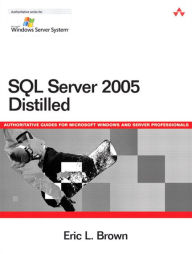Read an Excerpt
SQL Server 2005 DistilledSQL Server 2005 DistilledPreface
This book does not cover the entirety of SQL Server 2005. It doesn't include any fancy sample applications or tons of code. This book is about features. It is about understanding what the major features of SQL Server 2005 are designed to do. I strove to include an architectural discussion, usage scenarios, and interesting information about using the technology. I offer some opinions about how I'd expect a customer to really use a technology, as opposed to the marketing approach to presenting the technology.
In keeping with the Distilled series idea, I present not all the features, but the majority of the features that are new and significantly revised. Furthermore, I do not attempt to drill into every nook and cranny of the newest and greatest; instead, I describe them in a conceptual way. I process the features of SQL Server 2005 via a framework that includes an architectural discussion. By that I mean I focus on how the technology is designed. I also focus on customer scenarios. I tried to think in terms of the use-case scenario for the technology. In many cases, I try to offer a suggested "reality" usage based on customers' feedback about their experience with the product. The goal is to get you, the reader, up to speed on the "whats" and "hows" of SQL Server 2005. Chapter 6, "The Code Chapter," is the only chapter that includes any amount of code, and that code exercises the features in a simple manner, providing the nuts and bolts of the technique. I'll leave the creative and advanced techniques to the huge doorstop books that cover SQLServer 2005 in every detail.How to Use This Book
If you're an IT professional who has to deal with databases on any level, this book is a great foundation for getting to know SQL Server 2005. Many books today are too intimidating; they start with an application and spend literally hundreds of pages exercising that code. Often they do this without so much as a breath about how the code fits into the bigger picture. This book is different in this way: You get to know many features without getting mucked up in deep details, and you see how the features fit together. I cover each topic individually, meaning that you could read any chapter on its own. You can keep the book as a reference. Or you might use this book as an "airplane read" that helps refresh your conceptual knowledge of SQL Server 2005. That's the goal of this book: You can read it as needed, without worrying about too much minutia or too many code samples.Who Should Read This Book
This book is singular in that it's meant for technology decision makers, not hard-core developers or database administrators. (However, this would still be a good read for them, because it can be used to guide other learning about SQL Server 2005.) The technology decision maker will find the book invaluable, because you don't want to be caught at a cocktail party with your peers not knowing what the unified dimension model is.How This Book Is Organized
Chapter 1, "Introduction to SQL Server 2005," is an overview of the entire product—especially the new features across the OLTP and OLAP sides of SQL Server 2005. I cover all the basics of what's new and, as such, what should work for everybody. Chapter 2, "What Everyone Should Know About Security," provides an overview of what has unfortunately become one of the most important issues in database technology. The security professional is the most obvious target for Chapter 2, but given the importance of security these days, everyone can benefit from reading it. The goal of Chapter 2 is to bring you up to speed on the essential security features. Chapters 3 and 4 focus on two particular audiences: the database administrator and the database developer. Chapter 3, "Enterprise Data Management," covers all the new aspects of database administration in SQL Server 2005. Chapter 4, "Features for Database Development," covers the features of SQL Server 2005 that are relevant to database application development. Chapter 5, "Overview of Business Intelligence," is about how Microsoft is both catching up and innovating in the reporting and analytics space. It is not an OLAP concept primer; I assume you know what dimensions and cubes are. If you don't, please see SQL Server Books Online. Chapter 6, "The Code Chapter," is all code. I decided to have a dedicated code chapter because I hate having to scan hundreds of pages to find the one line of code I'm looking for. This chapter isn't and can't be all-inclusive. I simply cover the basics and assume you'll read the other excellent Addison-Wesley books on SQL Server 2005. My goal is to show you how easy (as in the case of new security features) or how hard (as in the table partitioning capabilities) using SQL Server 2005 can be.
© Copyright Pearson Education. All rights reserved.
